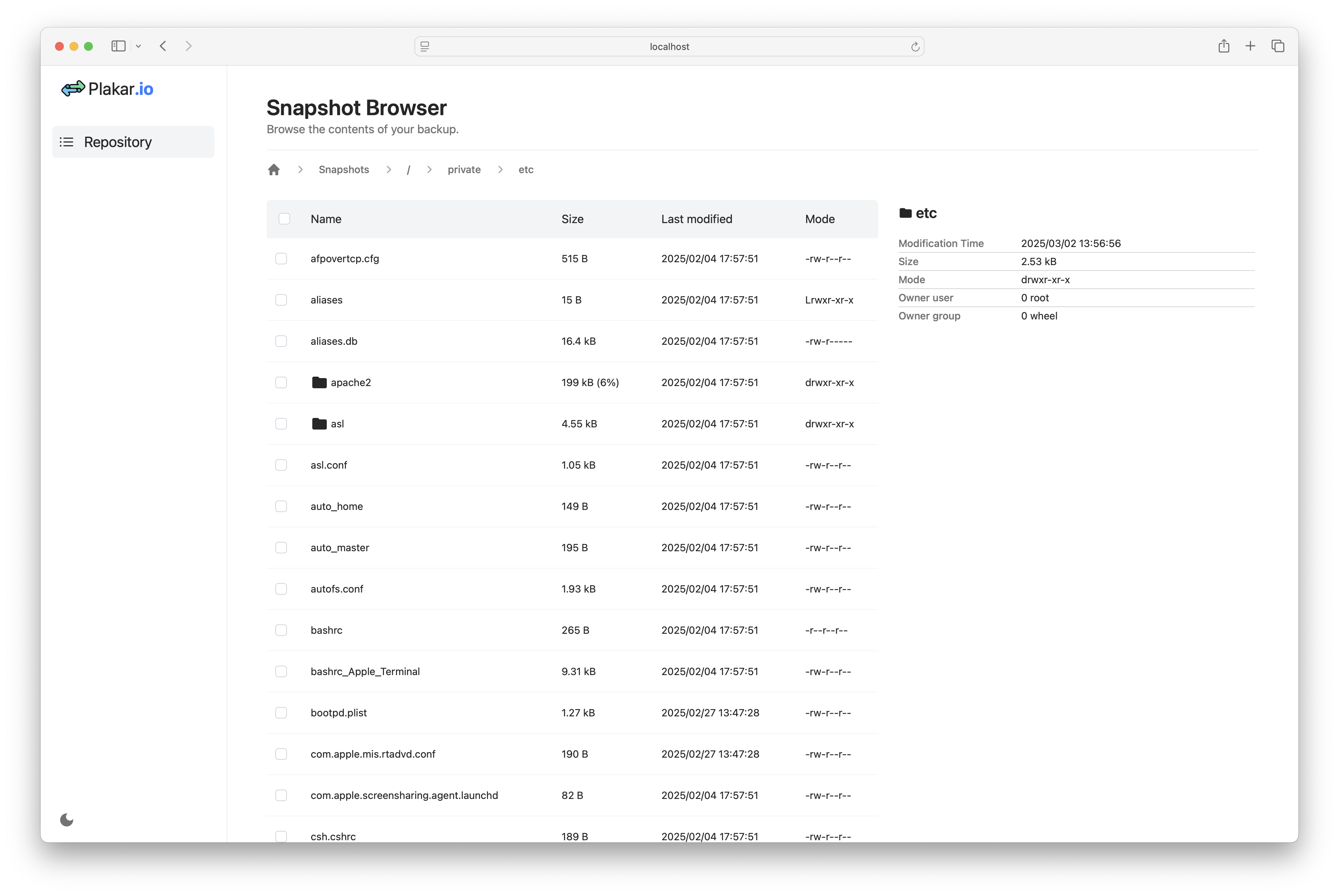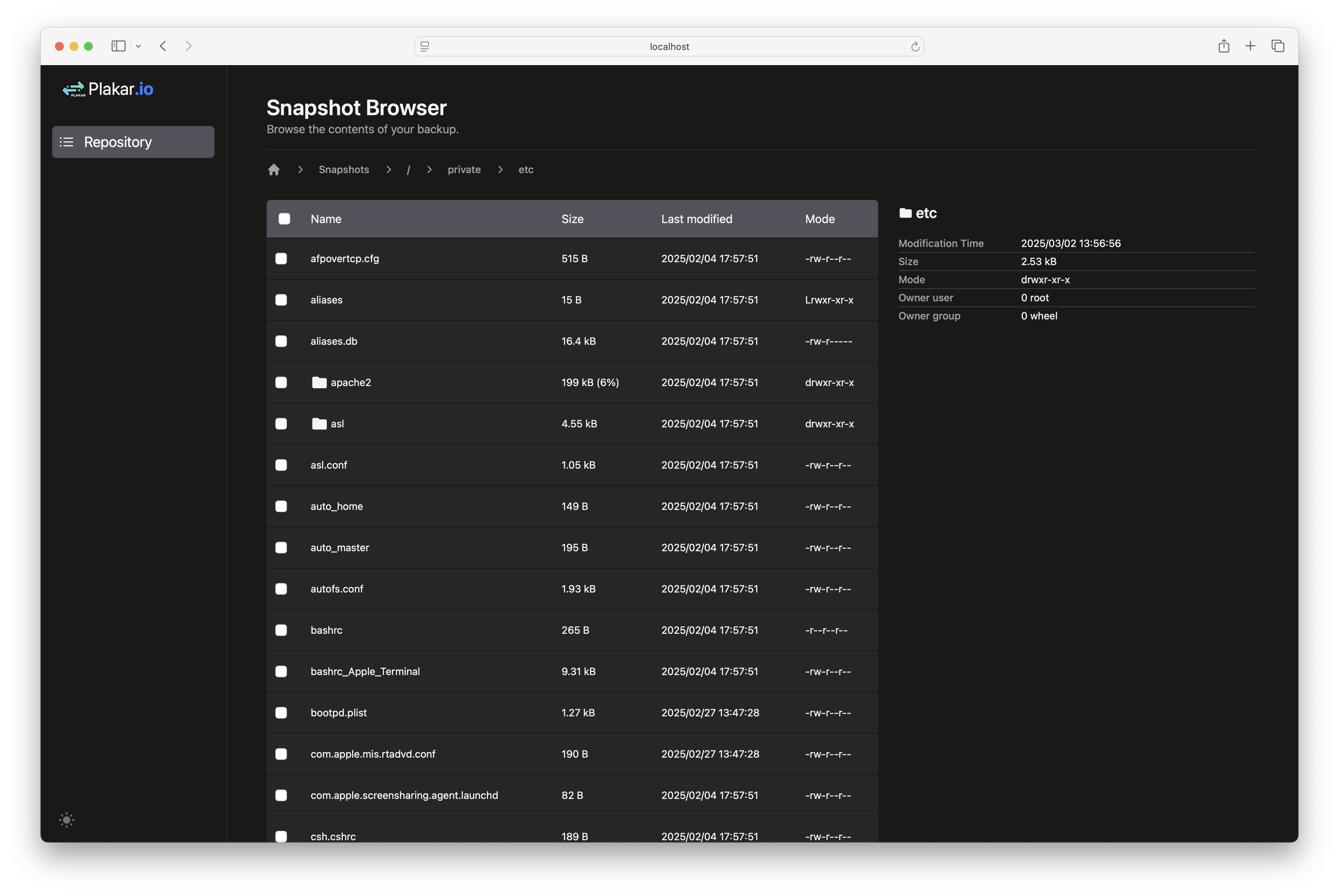This article will guide you through the creation of your first backup with plakar.
Installing plakar
Install plakar:
1$ go install github.com/PlakarKorp/plakar@main
To verify the installation was successful, run:
1$ plakar version
2v1.0.3-devel.c88dc607691070e29b39c3be11c330394bbb431f
Running the local agent
To work efficiently, plakar requires each user to run their local agent that will provide caching among other things. If the agent is not running, the plakar CLI will spawn it on first use.
Creating your first local repository
The plakar software reads your data, splits it into smaller chunks that it deduplicates and stores in a repository, a fancy word to designate storage space dedicated to hold these chunks.
A repository can be a directory on your local filesystem, a mountpoint to your NAS, a remote directory over SFTP, a bucket on an S3 object store, or any storage we provide (or you write) a connector for.
Our first repository will be a directory at
~/backups:
1$ plakar at ~/backups create
2repository passphrase:
3repository passphrase (confirm):
It is also possible to create unencrypted repositories, should your backups remain local, in which case the
-plaintextoption has to be passed at creation:
1$ plakar at ~/backups create -plaintext
Note that once a repository is created, it is no longer possible to change its configuration, such changes require creating a new repository and performing a synchronization between old and new repository.
Creating your first local backup
Once the repository is created, we can do the first backup to it:
1$ plakar at ~/backups backup /private/etc
29abc3294: OK ✓ /private/etc/ftpusers
39abc3294: OK ✓ /private/etc/asl/com.apple.iokit.power
49abc3294: OK ✓ /private/etc/pam.d/screensaver_new_ctk
5[...]
69abc3294: OK ✓ /private/etc/apache2
79abc3294: OK ✓ /private/etc
89abc3294: OK ✓ /private
99abc3294: OK ✓ /
10backup: created unsigned snapshot 9abc3294 of size 3.1 MiB in 72.55875ms
You can verify that it is properly recorded:
1$ plakar at ~/backups ls
22025-02-19T21:38:16Z 9abc3294 3.1 MiB 0s /private/etc
Verify the integrity of its content:
1$ plakar at ~/backups check 9abc3294
29abc3294: ✓ /private/etc/afpovertcp.cfg
39abc3294: ✓ /private/etc/apache2/extra/httpd-autoindex.conf
49abc3294: ✓ /private/etc/apache2/extra/httpd-dav.conf
5[...]
69abc3294: ✓ /private/etc/xtab
79abc3294: ✓ /private/etc/zshrc
89abc3294: ✓ /private/etc/zshrc_Apple_Terminal
99abc3294: ✓ /private/etc
10check: verification of 9abc3294:/private/etc completed successfully
And restore it to a local directory:
1$ plakar at ~/backups restore -to /tmp/restore 9abc3294
29abc3294: OK ✓ /private/etc/afpovertcp.cfg
39abc3294: OK ✓ /private/etc/apache2/extra/httpd-autoindex.conf
49abc3294: OK ✓ /private/etc/apache2/extra/httpd-dav.conf
5[...]
69abc3294: OK ✓ /private/etc/xtab
79abc3294: OK ✓ /private/etc/zprofile
89abc3294: OK ✓ /private/etc/zshrc
99abc3294: OK ✓ /private/etc/zshrc_Apple_Terminal
10restore: restoration of 9abc3294:/private/etc at /tmp/restore completed successfully
11$ ls -l /tmp/restore
12total 1784
13-rw-r--r--@ 1 gilles wheel 515 Feb 19 22:47 afpovertcp.cfg
14drwxr-xr-x@ 9 gilles wheel 288 Feb 19 22:47 apache2
15drwxr-xr-x@ 16 gilles wheel 512 Feb 19 22:47 asl
16[...]
17-rw-r--r--@ 1 gilles wheel 0 Feb 19 22:47 xtab
18-r--r--r--@ 1 gilles wheel 255 Feb 19 22:47 zprofile
19-r--r--r--@ 1 gilles wheel 3094 Feb 19 22:47 zshrc
20-rw-r--r--@ 1 gilles wheel 9335 Feb 19 22:47 zshrc_Apple_Terminal
Viewing the backup with the web interface
Plakar provides a web interface to view the backups and their content. To start the web interface, run:
1$ plakar at ~/backups ui
Your default browser will open a new tab. You can navigate through the snapshots, view the files, and restore them.


Digression: one copy is not enough
You’ve completed a backup, which is great. However, if you’ll allow me, I’d like to digress for a moment:
A local backup, as we just did, is helpful in case of accidental removal of the original data… but not so much if the storage is entirely lost.
As explained in the page One repository is not enough, the probability of losing data is as follows:
- For a single set of data: 5% per year (1 in 20 chance)
- For two copies at distinct sites: 0.00069% per year (1 in 145,000 chance)
- For three copies at distinct sites: 0.0000001% per year (1 in a billion chance)
To reduce the risk of data loss, it is highly recommended to create multiple copies of your backups across different locations.
Creating a second copy over SFTP
We now have a local repository with a copy of our backups, but it is done on the same machine: we’re currently at 5% chances of losing data this year if the drive dies.
Plakar has been designed to make it easy to synchronize repositories across multiple locations. Let’s create another repository on my remote NAS over SFTP and synchronize it with the local one: it should not take more than a couple of minutes.
This can be done by creating a new repository there, with its own passphrase:
1$ plakar at sftp://gilles@nas.plakar.io/home/gilles/backups create
2repository passphrase:
3repository passphrase (confirm):
We could simply do a new backup to it, but this might produce different snapshots as data may have changed since the first backup.
Instead, we can perform a repository synchronization.
A repository synchronization ensures that backups are transferred from a repository to another, using the recorded data,and performing necessary decryption and encryption to produce a similar copy:
1$ plakar at ~/backups sync to sftp://gilles@nas.plakar.io/home/gilles/backups
2peer repository passphrase:
3peer repository passphrase (confirm):
4sync: synchronized 1 snapshot
5info: sync: synchronization from /home/gilles/backups to sftp://gilles@nas.plakar.io/home/gilles/backups completed: 1 snapshots synchronized
6$ plakar at sftp://gilles@nas.plakar.io/home/gilles/backups ls
72025-02-19T21:38:16Z 9abc3294 3.1 MB 0s /private/etc
We can verify integrity of the snapshot on the second repository:
1$ plakar at sftp://gilles@nas.plakar.io/home/gilles/backups check 9abc3294
29abc3294: ✓ /private/etc/afpovertcp.cfg
39abc3294: ✓ /private/etc/apache2/extra/httpd-autoindex.conf
49abc3294: ✓ /private/etc/apache2/extra/httpd-dav.conf
5[...]
69abc3294: ✓ /private/etc/xtab
79abc3294: ✓ /private/etc/zshrc
89abc3294: ✓ /private/etc/zshrc_Apple_Terminal
99abc3294: ✓ /private/etc
10check: verification of 9abc3294:/ completed successfully
The probability of losing data this year has now fallen from 5% to 0.00069% (1 in 145,000)!
Creating a third copy over S3
Let’s create yet another repository on a remote S3 bucket!
1# for AWS, set s3://s3.<region>.amazonaws.com/<bucket>
2$ plakar store add s3 s3://minio.plakar.io:9001/mybackups \
3 passphrase=**************** \
4 access_key=gilles \
5 secret_access_key=********
Let’s do another synchronization!
1$ plakar at ~/backups sync to @s3
2sync: synchronization from /home/gilles/backups to s3://minio.plakar.io:9001/mybackups completed: 1 snapshots synchronized
3$ plakar at @s3 ls
42025-02-19T21:38:16Z 9abc3294 3.1 MB 0s /private/etc
We can verify integrity of the snapshot on the third repository:
1$ plakar at @s3 check 9abc3294
29abc3294: ✓ /private/etc/afpovertcp.cfg
39abc3294: ✓ /private/etc/apache2/extra/httpd-autoindex.conf
49abc3294: ✓ /private/etc/apache2/extra/httpd-dav.conf
5[...]
69abc3294: ✓ /private/etc/xtab
79abc3294: ✓ /private/etc/zshrc
89abc3294: ✓ /private/etc/zshrc_Apple_Terminal
99abc3294: ✓ /private/etc
10check: verification of 9abc3294:/private/etc completed successfully
But what if both my drive died AND the data center hosting my NAS burst in flames?
The probability of losing data has now fallen from 0.00069% to 0.0000001% (1 in a billion)!
A few additional words on synchronization
This first command locates snapshots that exist in my local repository but not in the remote one, then sends them over:
1$ plakar at ~/backups sync to @s3
This second command locates snapshots that exist in the remote repository but not in the local one to bring them over:
1$ plakar at ~/backups sync from @s3
And this last command does it both ways, pushing to the remote repositories snapshots that exist locally and are missing, but also fetching locally snapshots that only exist remotely:
1$ plakar at ~/backups sync with @s3
Repository synchronization is slightly more advanced than what was shown, and you are encouraged to experiment with it to find the best workflow for your use-case.
In addition, all these commands support passing snapshot identifiers and various options to perform partial synchronizations, only exchanging snapshots that match certain criteria. More information can be found in the documentation.
